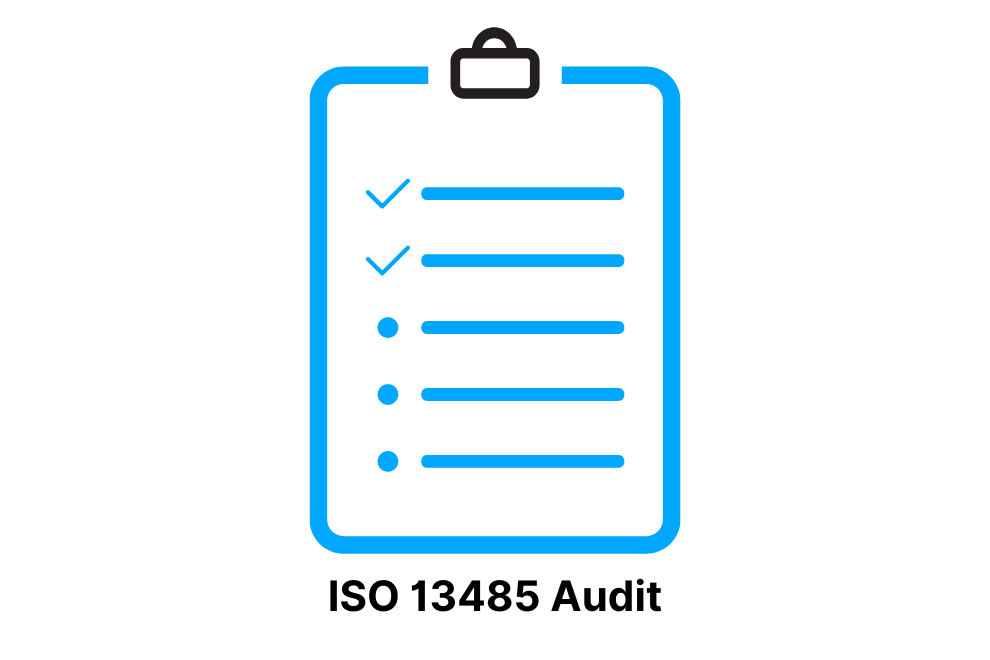ISO 13485 Audit: Ensuring Compliance and Quality

The ISO 13485 audit, also known as the certification audit, is a crucial step towards ensuring that medical devices meet regulatory requirements and international standards.
Understanding ISO 13485 audit and its significance is essential for all stakeholders in the industry.
In this blog, we will provide you with a comprehensive guide to ISO 13485 audit, including its key differences from FDA 21 CFR Part 820, different types of audits, frequency of audits, preparation guidelines, and possible outcomes.
We will also discuss how ISO 13485 compliance can benefit from quality management system software.
If you are looking to ensure compliance and improve the quality of your medical devices, read on to find out if your organization is ready for an ISO 13485 audit.
Table of Contents
Understanding ISO 13485 Audit
The ISO 13485 audit process provides valuable insights into the requirements and objectives of the ISO 13485 standard.
This certification is crucial for medical device manufacturers, as it ensures compliance with regulatory requirements and supports the safety and effectiveness objectives of the products they sell.
Implementing an effective quality management system (QMS) is essential to meet the complex demands of the industry and demonstrate that an adequate, effective quality system is established and maintained.
Internal audits and supplier audits help maintain conformance to quality standards.
The ISO 13485 audit is a time-consuming and rigorous process, but it enables organizations to demonstrate their commitment to quality assurance.
Significance of ISO 13485 in Medical Devices Industry
ISO 13485 is a quality management standard specifically developed for the medical device industry.
Compliance with this standard is crucial to ensure the safety and effectiveness of medical devices.
Moreover, ISO 13485 certification enhances the credibility and reputation of medical device manufacturers, enabling them to access international markets by demonstrating conformity to regulatory requirements.
Implementing ISO 13485 also improves overall quality management practices within medical device companies.
This standard plays a significant role in maintaining the quality assurance and conformance of medical devices in the fast-paced and highly regulated medical devices industry.
Differentiating ISO 13485 Audit from FDA 21 CFR Part 820
ISO 13485 audit and FDA 21 CFR Part 820 audit differ in their focus and scope.
While ISO 13485 audit evaluates compliance with the international standard, FDA 21 CFR Part 820 audit assesses adherence to specific regulatory requirements in the United States.
ISO 13485 audit covers a broader range of quality management system processes, while FDA 21 CFR Part 820 audit emphasizes risk management and regulatory compliance.
Both audits aim to ensure the quality and safety of medical devices but have different criteria.
Key Differences and Their Impacts on Medical Devices
ISO 13485 focuses on quality system processes, while FDA 21 CFR Part 820 emphasizes specific requirements.
ISO 13485 is recognized globally, enabling access to international markets, while FDA 21 CFR Part 820 compliance is essential for the U.S. market.
Adhering to both ensures compliance with global and U.S. regulatory requirements.
Non-compliance with ISO 13485 may limit market opportunities, while non-compliance with FDA 21 CFR Part 820 can result in regulatory actions.
Conforming to both standards is crucial for medical device manufacturers to ensure quality and meet regulatory demands.
Types of ISO 13485 Audits
There are three main types of ISO 13485 audits: in-house audits, third-party audits, and unannounced audits.
In-house audits are conducted internally by the organization’s own auditors to assess compliance with ISO 13485 requirements.
On the other hand, third-party audits are performed by independent certification bodies or registrars who evaluate the organization’s adherence to the standard.
Unannounced audits, as the name suggests, are visits to assess compliance at any given time.
Each type of audit serves a specific purpose in ensuring adherence to ISO 13485 requirements, and organizations may choose the audit type based on their specific needs and regulatory requirements.
In-house Audits
In-house audits play a crucial role in assessing an organization’s compliance with ISO 13485, the quality management system for medical devices.
Conducted by internal auditors, these audits evaluate the effectiveness of the organization’s quality management system and identify areas for improvement and risk mitigation.
Regular in-house audits not only help maintain a state of audit readiness for external assessments but also facilitate the implementation of corrective actions to enhance conformance with quality standards.
Additionally, they provide valuable opportunities for continuous improvement and ensure the organization’s readiness to manufacture and supply safe and effective medical devices to the market.
Third-party Audits
Third-party audits play a crucial role in ensuring compliance with ISO 13485 requirements and maintaining a high-quality system.
These audits are conducted by independent certification bodies or registrars, who send impartial auditors to verify an organization’s adherence to the standards.
By providing an objective assessment, third-party audits help organizations achieve ISO 13485 certification.
This certification is essential for accessing international markets and demonstrating compliance with quality standards.
Successful third-party audits validate the effectiveness of an organization’s quality management system and its ability to manufacture safe and effective medical devices.
In addition to document review, auditors also conduct physical verification of compliance through interviews and fact-based observations.
This ensures that the quality system processes are being followed throughout the entire product development cycle, as required by ISO 13485.
Surprise Audits
Surprise audits play a crucial role in ensuring compliance with ISO 13485, the quality standard for medical devices.
These unannounced visits provide a true representation of an organization’s day-to-day operations and help maintain the integrity of the certification process.
Organizations must be prepared at all times for surprise audits, as they assess ongoing adherence to the standard’s requirements.
By being vigilant and proactive, organizations can demonstrate their commitment to quality system processes and secure their position in the competitive European market.
How Often Should ISO 13485 Audits Occur?
ISO 13485 audits should occur based on regulatory requirements and the organization’s risk management approach.
Annual audits are common for maintaining certification, while high-risk organizations may need more frequent audits.
Surveillance audits can monitor compliance between recertification audits, ensuring alignment with quality objectives and regulations.
How to Effectively Prepare for an ISO 13485 Audit?
To effectively prepare for an ISO 13485 audit, start by conducting a gap analysis to identify areas for improvement. Review and update documentation to align with ISO 13485 requirements.
Train personnel on ISO 13485 standards and auditing techniques. Perform internal audits to assess readiness.
Develop an audit plan and ensure necessary resources are available.
Step-by-step Guide for Audit Preparation
Preparing for an ISO 13485 audit requires meticulous planning and attention to detail.
Start by organizing your audit documentation and ensuring compliance with ISO requirements, including the internal ISO 13485 audit training.
Conduct internal audits to identify any non-conformities and address them promptly.
It’s crucial to train your employees on quality management system processes and regulatory requirements, such as the internal ISO 13485 audit training, to ensure a smooth audit process.
Perform a comprehensive gap analysis to identify areas for improvement and take necessary corrective actions.
Finally, establish a cross-functional team to facilitate the audit and ensure effective collaboration.
Here’s an example of a table that you might use for an ISO 13485 audit. ISO 13485 is a standard for the design, development, and production of medical devices, so the audit table would typically cover aspects related to quality management and regulatory compliance:
| Audit Checklist Item | Compliance Status | Comments/Notes |
|---|---|---|
| Quality Policy | ||
| Management Review | ||
| Document Control | ||
| Records Management | ||
| Training & Competence | ||
| Risk Management | ||
| Design Control | ||
| Supplier Management | ||
| Product Realization | ||
| Validation & Verification | ||
| Monitoring & Measurement | ||
| Complaint Handling | ||
| Nonconformity & Corrective Actions | ||
| Internal Audits | ||
| Traceability | ||
| Packaging & Labeling | ||
| Sterilization (if applicable) | ||
| Regulatory Compliance | ||
| Post-market Surveillance |
In the “Compliance Status” column, you can indicate whether each item is compliant (Yes), non-compliant (No), or partially compliant (Partial), along with any relevant comments or notes in the “Comments/Notes” column. This table can serve as a checklist during the audit process to track the organization’s compliance with ISO 13485 requirements.
What to Expect During an ISO 13485 Audit?
During an ISO 13485 audit, an auditor will assess your organization’s quality management system by reviewing documentation, conducting interviews, and site inspections.
They will evaluate conformity to ISO 13485 standards and regulatory requirements through sample selection and physical verification.
Corrective actions may be required for non-conformities.
| ISO 13485 INTERNAL AUDIT CHECKLIST |
|---|
Audit Date: [Date]
Audit Scope: [Description of the scope of the audit]
Audited Department/Function: [Department or function audited]
Lead Auditor: [Lead auditor’s name]
Audit Team Members: [List of team members]
|————————————————————————-|
| KEY INFORMATION |
|————————————————————————-|
| Location: | Auditor-in-Charge: | Audit Duration: |
|---|---|---|
| [Location of the audit] | [Lead auditor’s name] | [Start – End] |
| —————————– | —————————- | —————— |
|————————————————————————-|
| AUDIT CRITERIA |
|————————————————————————-|
| ISO 13485:2016 Clause | Requirement Description |
|---|---|
| Clause 4 – Quality Management System | |
| —————————– | ——————————————- |
| 4.1 General requirements | [Description of compliance assessment] |
| —————————– | ——————————————- |
| 4.2 Documentation | |
| —————————– | ——————————————- |
| Clause 5 – Management Responsibility | |
| —————————– | ——————————————- |
| 5.1 Management commitment | |
| —————————– | ——————————————- |
| 5.2 Customer focus | |
| —————————– | ——————————————- |
| … | |
| —————————– | ——————————————- |
[Continue listing all relevant ISO 13485 clauses and their requirements]
|————————————————————————-|
| AUDIT FINDINGS |
|————————————————————————-|
| No. | Nonconformance Description | Severity | Status |
|---|---|---|---|
| 1 | [Description of nonconformance] | [High/Medium/ | [Open/ |
| Low] | Closed] | ||
| ——- | ————————————— | ————– | ——— |
| 2 | [Description of another nonconformance] | [High/Medium/ | [Open/ |
| Low] | Closed] | ||
| ——- | ————————————— | ————– | ——— |
| … | … | … | … |
|————————————————————————-|
| AUDIT RECOMMENDATIONS |
|————————————————————————-|
| No. | Recommendation Description | Priority | Status |
|---|---|---|---|
| 1 | [Description of recommendation] | [High/Medium/ | [Open/ |
| Low] | Closed] | ||
| ——- | ————————————— | ————– | ——— |
| 2 | [Description of another recommendation] | [High/Medium/ | [Open/ |
| Low] | Closed] | ||
| ——- | ————————————— | ————– | ——— |
| … | … | … | … |
|————————————————————————-|
| AUDIT CONCLUSION |
|---|
| Audit Findings: |
| [Summary of the audit findings and nonconformances] |
| Recommendations: |
| [Summary of the audit recommendations] |
| Overall Assessment: |
| [Overall assessment of the audited organization’s compliance] |
| ————————————————————————- |
Possible Outcomes and Their Implications
When conducting an ISO 13485 audit, there are several possible outcomes that can have implications for your organization.
If no major non-conformities are found during the audit, your organization may receive a certificate of conformity, demonstrating its compliance with quality standards.
However, if minor non-conformities are identified, corrective actions will need to be taken within a specified timeframe.
On the other hand, major non-conformities can lead to the suspension or withdrawal of your ISO 13485 certification, impacting your organization’s ability to manufacture and sell medical devices.
Non-compliance with regulatory requirements may result in penalties or restrictions on market access. To ensure continued compliance, ongoing surveillance audits may be conducted.
| AUDIT REPORT |
|---|
Audit Date: [Date]
Audit Type: [Internal/External]
Audit Scope: [Description of the scope of the audit]
Audited Organization: [Name of the organization]
Audited Department/Function: [Department or function audited]
Lead Auditor: [Lead auditor’s name]
Audit Team Members: [List of team members]
|————————————————————————-|
| KEY INFORMATION |
|————————————————————————-|
| Location: | Auditor-in-Charge: | Audit Duration: |
|---|---|---|
| [Location of the audit] | [Lead auditor’s name] | [Start – End] |
| —————————– | —————————- | —————— |
| Standards/Requirements: | Client Representative: | |
| —————————– | —————————- | |
| [Relevant standards or | [Client’s representative | |
| requirements audited] | attending the audit] | |
| —————————– | —————————- |
|————————————————————————-|
| AUDIT FINDINGS |
|————————————————————————-|
| No. | Nonconformance Description | Severity | Status |
|---|---|---|---|
| 1 | [Description of nonconformance] | [High/Medium/ | [Open/ |
| Low] | Closed] | ||
| ——- | ————————————— | ————– | ——— |
| 2 | [Description of another nonconformance] | [High/Medium/ | [Open/ |
| Low] | Closed] | ||
| ——- | ————————————— | ————– | ——— |
| … | … | … | … |
|————————————————————————-|
| AUDIT RECOMMENDATIONS |
|————————————————————————-|
| No. | Recommendation Description | Priority | Status |
|---|---|---|---|
| 1 | [Description of recommendation] | [High/Medium/ | [Open/ |
| Low] | Closed] | ||
| ——- | ————————————— | ————– | ——— |
| 2 | [Description of another recommendation] | [High/Medium/ | [Open/ |
| Low] | Closed] | ||
| ——- | ————————————— | ————– | ——— |
| … | … | … | … |
|————————————————————————-|
| AUDIT CONCLUSION |
|---|
| Audit Findings: |
| [Summary of the audit findings and nonconformances] |
| Recommendations: |
| [Summary of the audit recommendations] |
| Overall Assessment: |
| [Overall assessment of the audited organization’s compliance] |
| Auditor’s Signature: [Signature] Date: [Date] |
| ————————————————————————- |
How Does ISO 13485 Compliance Benefit with Quality Management System Software?
Quality management system software offers numerous benefits for ISO 13485 compliance.
It streamlines processes, ensures adherence to requirements, and enables efficient documentation management.
Real-time data analysis facilitates prompt corrective action, while improved traceability enhances overall quality and compliance.
Is Your Organization Ready for an ISO 13485 Audit?
Assess your organization’s preparedness with internal audits and gap analysis.
Train employees on ISO 13485 requirements and quality management processes.
Update documentation to align with ISO standards.
Employ a quality management system software for enhanced compliance and efficiency.
Engage a certified registrar for an external audit and certification.
| Topic | Statistic | Source |
|---|---|---|
| Average audit time | Calculated by many variables such as size, complexity, risk, and the nature of your organization | [ISO 13485 Certification – What Is the ISO 13485 Standard?] |
| Typical internal audit | Covers 2-4 areas of the organization each month throughout the year, depending on the size of the company | [ISO 13485:2016 Internal Audit Checklist] |
| Certification audit cycle | Lasts 3 years and each year there is a surveillance audit | [ISO 13485:2016 Certification Process] |
| Auditor’s task | Collect factual audit evidence using the sampling method and evaluate it against the audit criteria | [ISO 13485:2016 Auditing] |
| Audit guidelines | Provided by ISO 19011:2018 for auditing management systems | [ISO – ISO 19011:2018 – Guidelines for auditing management systems] |
Frequently Asked Questions
Conclusion
In conclusion, ISO 13485 audits play a critical role in ensuring compliance and maintaining high-quality standards in the medical devices industry.
These audits help identify gaps, improve processes, and ensure that organizations meet the requirements set by regulatory bodies.
Whether it’s an in-house audit, a third-party audit, or a surprise audit, preparing effectively is key to a successful outcome.
Investing in a quality management system software can greatly benefit ISO 13485 compliance efforts by streamlining processes, enhancing documentation, and facilitating continuous improvement.
If you want to ensure your organization is ready for an ISO 13485 audit, book a demo with PERFEQTA.


